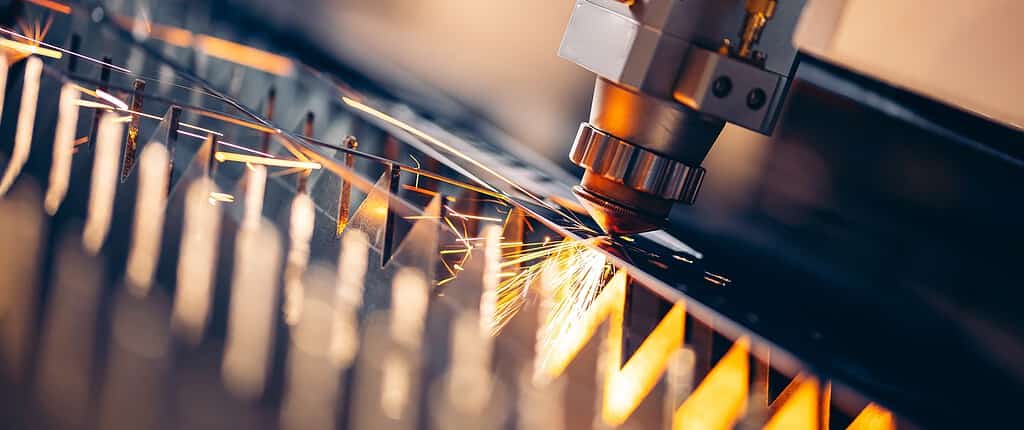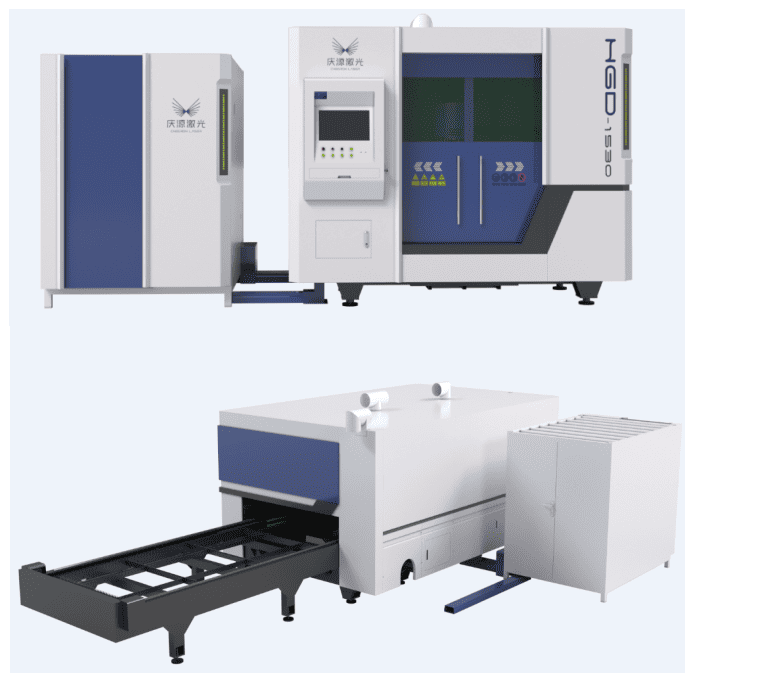Explore the transformative world of High-Speed Laser Cutting Machines in this in-depth guide. Gain insights into their cutting-edge characteristics, advantages, and applications, while uncovering crucial considerations for seamless integration. Whether you’re a seasoned industry professional or a curious enthusiast, discover the key to harnessing the full potential of these revolutionary machines in today’s dynamic manufacturing landscape.

Introduction
In today’s rapidly advancing manufacturing landscape, the significance of High-Speed Laser Cutting Machines cannot be overstated. These state-of-the-art tools have not only transformed the precision and efficiency of material processing but have also reshaped the contours of numerous industries. As the boundaries of what’s possible continue to expand, it becomes imperative for professionals and enthusiasts alike to grasp the nuances of these sophisticated machines.
This guide delves deep into the intricacies of High-Speed Laser Cutting Machines, presenting a detailed exploration. By unraveling their defining features, benefits, and potential challenges, we aim to equip readers with a comprehensive understanding, ensuring informed decisions and optimal utilization in diverse applications.

What characterizes a High-Speed Laser Cutting Machine?
High-Speed Laser Cutting Machines are distinguished by their ability to rapidly and precisely cut through various metal materials using laser technology. Key characteristics include:
Cutting Speed:
High-Speed Laser Cutting Machines are engineered for swift operations, ensuring faster production cycles.
Enhanced cutting rates reduce the overall processing time for parts and components, leading to increased productivity.
Faster cutting speeds mean quicker turnaround times for projects, enhancing the overall efficiency of manufacturing processes.
Precision:
Leveraging advanced motion control systems, these machines offer pinpoint accuracy in material processing.
The integration of sophisticated laser technologies ensures clean, sharp cuts with minimal material waste.
Exceptional precision allows for the creation of intricate designs and the achievement of tight tolerances, meeting the most demanding quality standards.
What advantages does a High-Speed Laser Cutting Machine offer in terms of productivity?
High-Speed Laser Cutting Machines are pivotal in the modern manufacturing landscape due to their unmatched efficiency and precision. Delving into their advantages:
Increased Throughput: One of the most notable benefits is the accelerated cutting speeds. This means that a higher volume of materials can be processed in a shorter time frame, allowing manufacturers to produce more finished products in a given period. Essentially, more output translates to higher revenue potential and quicker turnaround times for customers.
Reduced Downtime: These machines are designed for swift setup and seamless operation. Their advanced automation and integration capabilities ensure minimal manual intervention, leading to fewer interruptions in the production line. Consequently, this reduces the idle time of the machine, ensuring that it remains operational and productive for extended periods.

In what industries are High-Speed Laser Cutting Machines commonly used?
High-Speed Laser Cutting Machines have revolutionized manufacturing processes across a multitude of industries, thanks to their precision, speed, and efficiency. Here’s a detailed look into the industries that frequently leverage the capabilities of these machines:
Automotive: Within the automotive sector, High-Speed Laser Cutting Machines are instrumental in achieving precise cuts for a variety of car parts and components. Whether it’s intricate designs for interior components or precise body panels, these machines ensure consistency and accuracy, which are crucial for vehicle performance and aesthetics.
Aerospace: The aerospace industry demands components of unparalleled precision and tight tolerances. High-Speed Laser Cutting Machines play a pivotal role in fabricating complex aerospace parts. They can produce intricate designs with utmost accuracy, ensuring that the components meet the stringent quality and safety standards required in aerospace applications.
Electronics: In the realm of electronics manufacturing, where miniature components and intricate designs are the norm, High-Speed Laser Cutting Machines are indispensable. They enable high-speed, precise cutting for circuit boards, ensuring that electronic components fit seamlessly, thus enhancing the overall functionality and reliability of electronic devices.
Metal Fabrication: The metal fabrication industry benefits immensely from the capabilities of High-Speed Laser Cutting Machines. These machines excel in cutting and shaping metal sheets with remarkable speed and accuracy. Whether it’s creating prototypes, producing customized parts, or executing large-scale projects, these machines offer versatility and efficiency, making them a cornerstone in modern metal fabrication processes.
Are there limitations or specific considerations for using a High-Speed Laser Cutting Machine?
High-Speed Laser Cutting Machines represent a pivotal advancement in the machine industry, offering unparalleled precision and efficiency in material processing. However, like all technological innovations, they come with their set of limitations and considerations that potential users must be aware of.
Material Compatibility: One of the primary concerns with high-speed laser cutting is the compatibility of materials. Not all materials respond uniformly to high-speed cutting. Some may experience undesirable effects like charring, melting, or even deformation when subjected to rapid laser movements. It’s imperative to evaluate the specific material properties and their compatibility with high-speed operations before initiating any cutting processes.
Energy Consumption: The accelerated pace of high-speed laser cutting inherently demands more energy. As the machine operates at increased speeds, the energy requirements rise correspondingly. This can translate to higher operational costs. Users need to factor in these energy demands and explore ways to optimize energy usage without compromising on cutting quality.
Initial Cost: Investing in a high-speed laser cutting machine represents a significant financial commitment. Given the advanced technology and precision engineering involved, these machines typically come with a premium price tag. While the initial cost might seem prohibitive, it’s essential to weigh it against the long-term benefits, such as increased productivity, reduced processing times, and enhanced product quality. Potential buyers should conduct a thorough cost-benefit analysis to determine the machine’s viability for their specific applications.
Can High-Speed Laser Cutting Machines maintain cutting precision at increased speeds?
High-Speed Laser Cutting Machines have revolutionized the manufacturing industry by offering rapid and precise cutting solutions. Contrary to the common misconception that increased speed might compromise cutting accuracy, these machines are meticulously engineered to uphold impeccable precision even at elevated velocities.
One of the key advancements ensuring this is the integration of automatic focusing systems. These systems continuously adjust the focal length of the laser beam, ensuring it remains optimal for precise cutting at all times. Furthermore, real-time monitoring systems play a pivotal role. By constantly tracking and adjusting various parameters during the cutting operation, these systems ensure that any deviations or inconsistencies are promptly identified and corrected, guaranteeing that the end product meets the stringent accuracy standards expected in modern manufacturing processes.
What factors influence the overall speed of a Laser Cutting Machine?
The speed of a Laser Cutting Machine is a critical parameter that determines its efficiency and productivity. Several factors come into play when considering the overall speed of such a machine:
Laser Power: One of the primary determinants of cutting speed is the laser power. Machines with higher laser power can cut through materials more quickly than those with lower power. A stronger laser beam delivers more energy to the material, resulting in faster and more efficient cutting processes.
Motion Control System: The motion control system of the machine is another pivotal factor influencing its speed. This system dictates how swiftly and accurately the laser head can move across the material. An advanced and efficient motion control system ensures smooth and precise movements, thereby optimizing cutting speed and quality.
Material Type: The type of material being cut also significantly impacts the machine’s speed. Different materials possess varying densities, thicknesses, and thermal properties, necessitating adjustments in cutting speed.
Are there safety measures that need to be emphasized when working with High-Speed Laser Cutting Machines?
Safety in the machine industry, particularly when dealing with high-speed laser cutting machines, is of utmost importance to ensure the well-being of operators and prevent potential hazards. To maintain a safe environment and minimize risks, several safety measures must be emphasized:
Protective Gear: Operators must always wear the necessary protective gear. This includes:
Safety Glasses: These protect the eyes from direct exposure to the laser beam, which can cause severe damage or blindness.
Protective Clothing: Specialized clothing made from materials resistant to high temperatures and sparks should be worn to shield against potential burns or injuries from metal splashes.
Ventilation: Effective ventilation systems play a crucial role in maintaining a safe workspace:
Fume Extraction: High-speed laser cutting generates fumes that can be hazardous if inhaled. Proper ventilation ensures that these fumes are extracted, reducing the risk of respiratory issues.
Temperature Regulation: The process can produce significant heat. Proper ventilation helps dissipate this heat, preventing overheating and potential damage to the machine or surrounding equipment.
Training: Knowledge and awareness are pivotal in ensuring safety around high-speed laser cutting machines:
Machine Operation: Operators should undergo comprehensive training on how to operate the machine, understanding its functionalities, and ensuring they can handle any unexpected situations.
Safety Protocols: Apart from machine operation, operators must be well-versed in safety protocols. This includes emergency shutdown procedures, understanding warning signals, and knowing how to respond in case of accidents or malfunctions.
What maintenance requirements are associated with High-Speed Laser Cutting Machines?
High-speed laser cutting machines are intricate pieces of equipment that demand meticulous care to operate at peak efficiency. Regular maintenance is paramount to ensure longevity and precision. One of the key maintenance tasks is Laser Calibration, which involves periodic checks to guarantee that the laser’s accuracy and alignment are maintained. Additionally, Cleaning and Lubrication play a pivotal role; ensuring components are free from debris and adequately lubricated minimizes friction, reducing wear and tear on the machine.
What considerations should be taken into account when selecting a High-Speed Laser Cutting Machine for a specific application?
When selecting a High-Speed Laser Cutting Machine for a specific application within the machine industry, several critical considerations must be addressed to ensure optimal performance and efficiency. Firstly, Material Compatibility stands paramount. The machine’s ability to handle and cut the specific materials pertinent to your application is essential. Different lasers have varying affinities for materials, so ensuring a match is crucial. Secondly, one must assess the Cutting Speed Requirements. The machine’s speed capabilities should align seamlessly with the application’s demands to avoid inefficiencies or delays.
Lastly, Scalability is a pivotal factor. As industries evolve and production volumes fluctuate, the machine’s adaptability and potential for expansion become invaluable. Ensuring that the selected machine can accommodate future production needs guarantees longevity and a more significant return on investment.
Conclusion
High-Speed Laser Cutting Machines represent a pinnacle of modern manufacturing technology, combining rapidity, precision, and adaptability to redefine production capabilities. As detailed in this comprehensive guide, their impact spans across various industries, from automotive to aerospace, electronics to metal fabrication.
While these machines herald unparalleled efficiency, it’s essential to approach their integration with a nuanced understanding of considerations like material compatibility, energy consumption, and safety protocols. As we stand on the cusp of a new era in manufacturing, High-Speed Laser Cutting Machines undoubtedly emerge as indispensable tools, shaping the trajectory of industrial progress and innovation.
